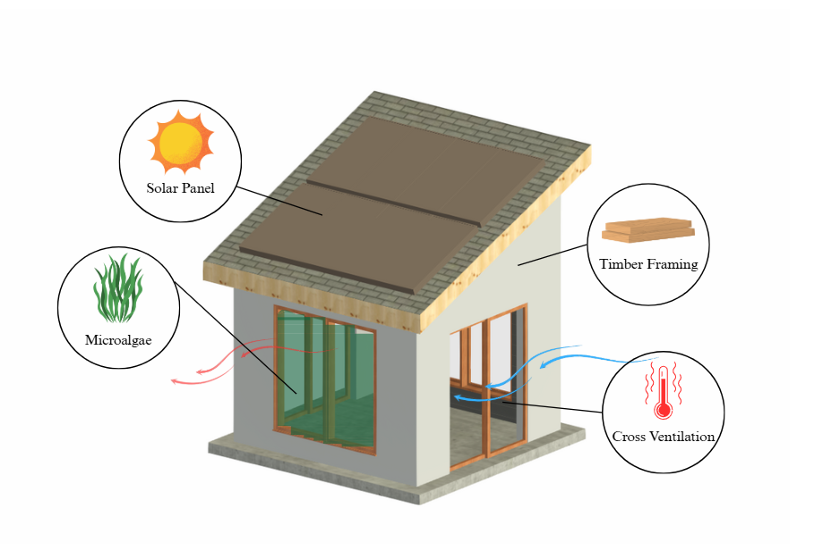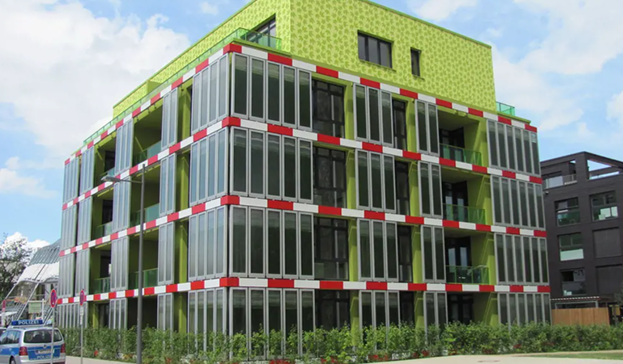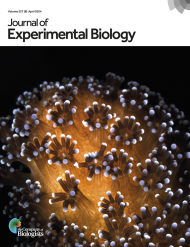21 November 2025
By Tan Hooi Wen
We are delighted to present to you the first prize-winning essay by Tan Hooi Wen (Taylor University) from our essay competition, ‘Innovative ideas for the future of sustainable events’. We received a high number of thoughtful and innovative essays, and while it was a tough decision for our Sustainability Board to make, this essay stands out. Here is Tan Hooi Wen’s innovative idea that could make the events of the future more sustainable:
1. Introduction
Scientific conferences are vital for innovation and knowledge sharing, but they carry a heavy environmental cost. Lund University (2024) reports that each international delegate emits an average of 1.3 tonnes of CO₂— exceeding nearly half the 2.3-tonne annual per capita limit recommended by the Paris Agreement. In other words, a single conference attendee becomes the “elephant in the room”—a major source of emissions that is rarely addressed. Most emissions stem from long-distance travel, energy-intensive venues and unsustainable practices like air conditioning and single-use materials.
This essay presents a sustainable solution: zero-footprint hubs—4m² prefabricated micro-event pods placed in public spaces. Powered by algae and solar energy and designed with passive and biophilic principles, these hubs reduce emissions while making scientific exchange more accessible. This essay explores challenges in current event practices, outlines the proposed solution, compares emissions and highlights real-world case studies.
2. Theme Analysis
Modern challenges
Based on articles by EasyWebinar (2024), the traditional model of centralized scientific events presents several environmental challenges that make it increasingly unsustainable in today’s climate-conscious world. Long-distance travel—particularly by air—is a major contributor, often accounting for the largest portion of an event’s carbon footprint, with 10–20% of participants responsible for 20–70% of transportation-related emissions. Large venues also consume vast amounts of energy for heating, cooling and powering IT infrastructure such as lighting, sound systems and networking equipment, all of which are typically powered by non-renewable sources. Additionally, events also generate excessive waste from promotional materials, single-use plastics, and leftover food.
Collectively, these factors highlight the environmental costs of traditional in-person gatherings and underscore the need for more sustainable alternatives.
Technological innovations to address challenges
The zero-footprint hub tackles the environmental impact of traditional conferences through three sustainable strategies. First, its decentralized and prefabricated design allows small hubs to be deployed in public spaces such as parks and campuses, reducing the need for long-distance travel. Prefabrication lowers the carbon footprint by up to 40% compared to conventional construction (Graham, 2024).
Second, the hub runs off-grid using renewable energy. Algae-based micro photosynthetic cells generate electricity from photosynthesis by capturing electrons (Alymer, 2024), while rooftop solar panels provide up to 2 kW/day as backup (Zientara, 2025). A smart control system manages energy flow and storage.
Third, passive design strategies—such as cross-ventilation through both sides of the hub opening up CO2 and daylighting via translucent algae biopanels—minimize energy use. Timber framing further reduces embodied carbon by storing CO₂ emissions, providing a low-carbon alternative to concrete and steel (Timber Media Australasia, 2023). These innovations make the hub a scalable, low-impact solution for sustainable scientific exchange.
CO₂ Emission Comparison
As shown in Figure 1, the CO₂ emissions were estimated using the standard formula provided by Diginex (2025):
E = A × EF × (1 – ER/100)
where E = Emissions (kg or tonnes of CO₂); A = Activity level (e.g., km traveled, kWh used); EF = Emission factor (amount of CO₂ per unit activity); ER = Overall emission reduction efficiency (%).

Figure 1. Comparison of estimated CO₂ emissions between a Traditional Conference Model and the Micro-Pod Model, based on 1,000 participants. The Micro-Pod Model shows over 90% reduction in emissions by minimizing travel, using renewable energy and relying on low-impact materials. Generated by ChatGPT (OpenAI), 2025.
Functional workflow of the zero-footprint hub
At the core of the zero-footprint hub is a microalgae biopanel system that uses photosynthesis to generate electricity. Non-toxic algae like Chlorella vulgaris absorb sunlight and produce a steady flow of electrons, powering low-energy devices such as sensors and microprocessors (Cambridge University, 2022). Simultaneously, the algae absorb CO₂, making the system carbon-negative through natural sequestration (refer to Figure 2).

Figure 2. How sunlight is harnessed by microalgae in a spectrally-selective photobioreactor (PV-PBR). Visible light (VL) powers photosynthesis in algae, enabling them to produce biomass, while semi-transparent photovoltaic layers convert light into electrical energy by harvesting electrons (e⁻). This dual-output system produces both renewable energy and algal biomass, supporting a carbon-negative cycle. Using algae as an energy source inside the façades in Hamburg, Germany. From P. Horvath, IOP Conference Series: Earth and Environmental Science, vol. 397, 012007, 2025. Licensed under Creative Commons Attribution 4.0 (CC BY 4.0). Source: Design Boom. https://iopscience.iop.org/article/10.1088/1755-1315/397/1/012007/pdf
According to Professor Chris Howe, the system “doesn’t run down the way a battery does,” as it continuously draws energy from sunlight. The end product of the algae’s metabolic process is biomass, which can be collected and repurposed for the food or pharmaceutical industries, promoting circular resource use. The conceptual illustration of the zero-footprint hub can be seen in Figure 3.

Figure 3. Conceptual illustration that highlights the zero-footprint hub’s sustainable features: live microalgae facade panels that generate electricity and sequester carbon, rooftop solar panels for backup, low-carbon timber framing and passive cross ventilation. These elements create a biophilic, self-sustaining system where humans, nature and microalgae coexist.
Case studies and applications
To support the feasibility and potential of the zero-footprint hub, real-world applications of microalgae technology in architecture are examined. These pioneering projects demonstrate how algae can be integrated into building systems to produce energy, reduce carbon emissions, and enhance sustainability in urban environments.
As shown in Figure 4, the BIQ House in Germany is the first building with a full-scale algae façade. Its photobioreactor panels generate biomass and solar thermal energy while providing shading and insulation. This reduces reliance on mechanical cooling and demonstrates algae’s potential as a dual-purpose system for energy production and façade efficiency (WTWH Media, 2020).

Figure 4. IBA Hamburg BIQ. Photo by NordNordWest. Licensed under CC BY-SA 3.0 DE. Source: Wikimedia Commons. https://commons.wikimedia.org/wiki/File:IBA_Hamburg_BIQ_%282%29.nnw.jpg
Furthermore, Figure 5 shows the algae dome which was developed by SPACE10, IKEA’s research lab. It is a mobile pavilion that grows spirulina algae in transparent tubes. Serving as an educational installation, it highlights how microalgae can be cultivated in urban settings for food and oxygen, showcasing algae’s potential for sustainable, community-focused applications (Morris, 2017).

Figure 5. The design of an algae street light. From P. Horvath, IOP Conference Series: Earth and Environmental Science, vol. 397, 012007, 2025. Licensed under CC BY 4.0. Source: Design Boom. https://iopscience.iop.org/article/10.1088/1755-1315/397/1/012007/pdf
3. Critical reflection
The zero-footprint hub offers a regenerative architectural approach by combining technological innovation with environmental awareness. Its main strength is the dual renewable energy system using solar and microalgae, which promotes carbon-negative technologies by absorbing CO₂. The biophilic design also supports well-being and connects people with nature.
However, limitations such as the niche nature of microalgae technology, high initial setup costs and potential maintenance challenges may hinder scalability. A key threat is that microalgae systems are not yet competitive with conventional energy sources like photovoltaics, producing a maximum terminal voltage of only 1.0 V per cell (Concordia University, 2023). Despite this, researchers like Packirisamy believe future integration with AI and biodegradable materials could boost viability and lower costs. These advantages, along with emerging trends in net-zero architecture and algae-based industries, point to significant opportunities for interdisciplinary collaboration. To ensure long-term success, strategies should include public education, financial incentives and continued R&D to improve energy yield and scalability. The hub ultimately serves as a prototype for carbon-negative, sustainable urban living.
4. Conclusion
In response to the urgent need for sustainable solutions, this essay proposes a zero-footprint hub that uses biophotovoltaic technology to generate clean energy and sequester carbon. By decentralizing events and integrating algae-based systems into public spaces, it tackles both environmental and spatial challenges. Combining microalgae biopanels, renewable materials and passive design, the hub shows how architecture can align with nature. Though still emerging, algae technology holds great promise. With continued innovation, collaboration, and public support, these hubs could play a vital role in achieving a carbon-neutral built environment.
References
- Aylmer, J. (2024, June 14). Concordia University team uses algae for carbon-negative clean energy solution. Straight Arrow News. https://san.com/cc/concordia-university- team-uses-algae-for-carbon-negative-clean-energy- solution/#:~:text=In%20order%20to%20harness%20the,into%20a%20continuous%20ele ctric%20current
- Cambridge University. (2022, May 12). Algae-powered computing: Scientists create reliable and renewable biological photovoltaic cells. https://www.cam.ac.uk/research/news/scientists-create-reliable-biological-photovoltaic- cell-using- algae?utm_source=Social+Media&utm_medium=Video&utm_campaign=Research
- (2025). How to calculate carbon emissions. https://www.diginex.com/insights/how-to-calculate-carbon-emissions
- (2024). Sustainable webinars: How virtual events are reducing the carbon footprint. https://easywebinar.com/how-virtual-events-are-reducing-the-carbon-footprint/
- Graham, (2024, August 19). The rise of prefabricated construction: 5 benefits for efficiency and sustainability. PlanRadar. https://www.planradar.com/au/the-rise-of- prefabricated-construction/
- Lejtenyi, (2024, June 11). Algae offer real potential as a renewable electricity source, new Concordia research shows Internet of Things devices are among what could be powered using photosynthesis. Concordia University. https://www.concordia.ca/news/stories/2024/06/11/algae-offer-real-potential-as-a- renewable-electricity-source-new-concordia-research-shows.html
- Lund University. (2024, May 14). Conferences make scientists climate transgressors. https://www.lunduniversity.lu.se/article/conferences-make-scientists-climate- transgressors#:~:text=The%20average%20emissions%20per%20delegate,and%201.4% 20tonnes%20by%202040.
- Morris, (2017, September 10). IKEA lab Space10 creates algae-producing pavilion in Copenhagen. Dezeen. https://www.dezeen.com/2017/09/10/ikea-space10-algae- producing-pavilion-copenhagen/
- (2023). ChatGPT (Mar 23 version) [Large language model]. https://chat.openai.com/
- Timber Media Australasia. (2023, July 19). Embodied carbon in timber buildings. https://www.timbertradernews.com/2023/07/19/embodied-carbon-in-timber-buildings/
- WTWH (2020, December 11). The first algae-powered building presents unique renewable energy solution. https://www.engineering.com/the-first-algae-powered- building-presents-unique-renewable-energy-solution/
- Zientara, B. (2025). How much energy does a solar panel produce? Solar Reviews. https://www.solarreviews.com/blog/how-much-electricity-does-a-solar-panel- produce#:~:text=On%20average%2C%20a%20solar%20panel%20will%20generate%20 about%202%20kWh,TV%20for%2024%20straight%20hour
I acknowledge the use of ChatGPT (https://chat.openai.com/) to refine the academic language and accuracy of my work. The prompts included requests to enhance academic tone, improve grammatical structures, shorten sentences, and expand vocabulary. The output was subsequently modified to better reflect my own thoughts and ideas with added clarification.








You must be logged in to post a comment.